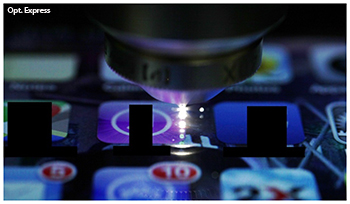
The waveguide (horizontal line, left side) written into the smartphone screen cannot be seen by the naked eye. The white light comes from the plasma generated by the nonlinear absorption of the laser. This waveguide was created in only 10 seconds.
A new femtosecond (fs) laser etching technique could add functionality to the glass screen on your smartphone (Opt. Express, DOI:10.1364/OE.22.015473). Researchers from several research centers in Montreal, Canada, and from Corning, Inc., U.S.A., created a method of carving waveguides into Gorilla Glass that could allow sensors to be installed in the glass itself. These new “apps” may include biomedical sensors that could help monitor your health.
To make the sensors, the team used a fs laser with an average power of 1 W, a focusing lens and a 3-axes motorized stage to carve layers of waveguides into the glass. This isn’t the first time someone has carved waveguides into glass, but it’s a new technique for Gorilla Glass—a strong, durable glass designed by Corning specifically for electronic devices. The glass-etched 3-D waveguides are about 10 times better at minimizing light loss than other glass etching techniques (0.027 dB/cm loss). The method is also cheaper and easier than chemical etching.
The team used their new technology to create two apps: a temperature sensor and an application for smartphone authentication with IR light. The temperature sensor consists of a straight and curved waveguide. When someone touches the screen, body heat causes the glass to expand, changing the length of the waveguides. By measuring this change, the device can calculate temperature. The smartphone authentication app is made up of waveguides with a unique pattern of holes. The phone “fingerprint” can be seen with an IR detector, thereby confirming the identity of the phone. Conducting financial transactions may also be safer with a waveguide-based app, since IR light cannot be captured through most solid materials, unlike radio frequencies.
The researchers are patenting the temperature sensor and authentication apps. They predict that the fs laser etching technique could be used on glass in different environments, like windows and tabletops, turning them into transparent touchscreens.
